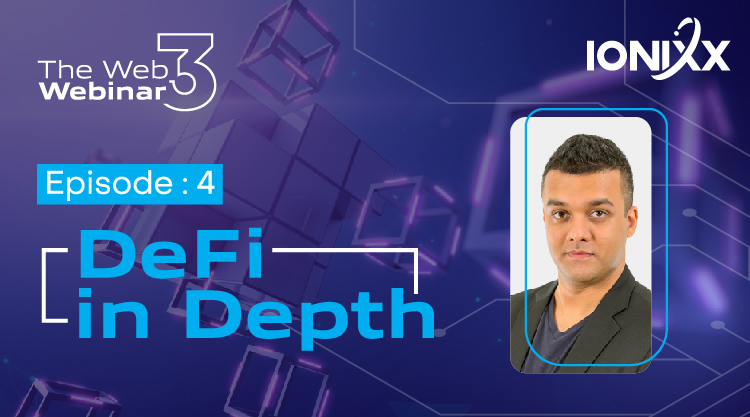
DeFi is short for Decentralized Finance. DeFi is the ecosystem of fintech apps built on top of blockchain protocols and therefore decentralized in nature. Most DeFi apps are built on top of the Ethereum blockchain, but as new blockchain protocols gain popularity, the DeFi ecosystem is likely to expand.
Traditional finance operates in a centralized manner with complex procedures, intermediaries, and checks and balances in place. Traditional finance has high fees associated with it due to procedural complexity and the number of parties involved, even for reasonably simple transactions. Traditional finance also leaves out a good portion of the world’s population, referred to as the “unbanked.” These users aren’t served by conventional finance because the cost of serving these users is higher than what could potentially be earned from them in the form of transaction fees.
What is DeFi
DeFi is a movement built on top of blockchain technology. DeFi aims to create an inclusive, decentralized, permissionless, censor-proof, transparent and open-source financial system available to anyone with a cryptocurrency wallet, smart device and internet connection. In DeFi systems, users interact with the network using DApps and peer-to-peer networks. Unlike traditional finance in DeFi systems, users maintain complete control over their assets. Once users deposit their money on the platform, they decide how to manage their investments using smart contracts rather than trusting human intermediaries to do the job.
Smart Contracts
DeFi applications turn financial rules and procedures into smart contracts and code. This helps to automate the processes and make them accessible to everyone on the platform. By turning the rules into code embedded within smart contracts, users can automatically execute a wide range of processes with the click of a button, which would be expensive to do and require manual supervision in traditional finance.
Smart contracts make the transactions faster, cheaper, easier, and more secure for all parties involved.
Advantages of DeFi
Democratized Finance
DeFi democratizes access to financial services. Users can access DeFi systems across the world regardless of their jurisdiction and financial status. All they need to participate is a smart device, a cryptocurrency wallet, and an internet connection.
Permissionless
DeFi networks are inherently permission-less and censor-proof, meaning there is no central authority that has the power to allow or stop a user from participating. There are no gatekeepers in these networks that can prevent users from accessing their solutions; everyone is free to join and transact with one another.
Decentralized & Interoperable
DeFi applications are built on decentralized blockchain networks which don’t have a single point of failure. Most blockchains are interoperable; this means a user can transact across platforms and asset classes.
Accessible Globally
DeFi networks are available everywhere; all users need to access them is an internet connection, a cryptocurrency wallet, and a smart device. No government, credit authority, or geographic constraint can stop a user from participating. DApps are designed to be available globally.
Peer to Peer
DeFi applications do not require the presence of arbitrators or intermediaries. The logic of each transaction type is embedded in code and agreed upon by users digitally. This reduces any associated arbitration costs and enables the applications to offer their services at highly competitive price points.
Transparent
The code and terms of transactions in DeFi are transparent. Users can review and audit them in real-time.
DeFi Use Cases
Lending
Lending platforms allow borrowers and lenders to transact with one another using smart contracts instead of intermediaries. Lenders can earn interest on their crypto by offering them on loan to a borrower. In comparison, borrowers can access additional liquidity without having to sell their assets.
StableCoins
Stablecoins, as their names suggest, aren’t as volatile as other cryptocurrencies because they are backed by real-world assets or pegged to a real-world fiat currency. Stablecoins make it easy to tokenize real-world assets and then enable trading these assets on blockchain-based platforms.
Decentralized Exchanges (DEXes)
Decentralized Exchanges offer services that are similar to regular crypto and digital asset exchanges, except that they remove the need for storing the digital assets on the exchange. These exchanges enable instant peer-to-peer transactions and operate without an intermediary. Once an exchange of assets or trade has been initialized, a series of smart contracts ensure the proper execution of the trade and the secure transfer of funds.
Prediction Markets
Users make bets about the outcome of future events on prediction markets. Prediction markets on DeFi platforms operate without intermediaries.
Notable Concepts
Composability
DeFi apps are usually open-source, meaning anyone can view and use the code that underlies these apps. New larger apps and solutions can be built or “composed” using this open-source code as building blocks.
Money Legos
Building on the concept of composability, you can think of DeFi apps as lego blocks which are joined together to build more comprehensive solutions. People in the DeFi community often refer to these building blocks as “money legos” which can be used to create new financial products
Liquidity Mining
Liquidity mining is the act of providing “liquidity” to Decentralized Exchanges by lending crypto holdings to them for a fee. DEXes provide liquidity to their clients and reward users willing to deposit their crypto on their platform because it increases liquidity.
Yield Farming
Yield farming is a way users can generate rewards with their crypto holdings by lending them to a protocol. Traders who are willing to take higher risks engage in complex strategies and move their crypto through different lending platforms to maximize their return. Yield farming is a form of liquidity mining, except it employs more complex techniques to maximize returns.
Impermanent Loss
Liquidity providers deposit trading pairs with DEXes in exchange for fees. The temporary loss experienced by volatility in a trading pair is called impermanent loss. Only if the liquidity provider decides to withdraw their liquidity for good does impermanent loss become permanent.
Challenges & Risks
While DeFi has a promising future there are a few challenges that users should be aware of.
Adoption Rates
The adoption rate remains a challenge in the DeFi space. A fraction of overall crypto users are active in DeFi. In theory, once a user has an internet connection, a crypto wallet, and a smart device, they can use DeFi apps. Still, the adoption rate remains low in part due to the perceived difficulty in starting and operating a crypto wallet. While seasoned crypto enthusiasts may find it easy to use Metamask, Shapeshift and other crypto wallets, the average non-crypto users shy away from the space, citing the difficulty of using wallets as their primary difficulty.
Bandwidth
While credit card processors can support thousands of transactions per second, public blockchain networks can only support a handful of transactions at a time. There are several projects underway to make public blockchain networks more scalable, such as the lightning network. The latest blockchain protocols being developed are also able to support a higher number of transactions per second.
Crypto Volatility
The volatility of cryptocurrency prices is another challenge for DeFi. Wild price swings in BTC and other major cryptocurrencies threaten to undermine the stability of DeFi apps and invalidate user strategies. Stablecoins provide a sense of security, but they cannot be used for every transaction on DeFi platforms.
Badly Written Smart Contracts
Smart contracts are the backbone of every DeFi protocol; they govern and quantify the transactions between users. Smart contracts in the DeFi space are open-source so that users can review them before investing. Security firms and other users often audit these open-source smart contracts, but flaws in the code sometimes remain undetected. Once users engage with these problematic smart contracts, it becomes incredibly tedious and time-consuming for DeFi platforms to undo these transactions.
Conclusion
The goal of DeFi platforms is to disrupt financial intermediaries and democratize finance. While there are a few challenges, multiple solutions to address these challenges are currently under development. I believe that DeFi will inevitably disrupt the world of traditional finance in the medium to long term and create a more inclusive and democratic banking environment for everyone.
With our DeFi services, we translate financial logic and processes into code. Besides, we help build robust smart contracts for your DeFi project end-to-end with integration of On-chain and off-chain oracles. You have a technology execution partner in us in case you want to launch your DeFi project live. Get in touch!
This blog is originally published here, https://medium.com/lansaar/defi-in-depth-bf425e6ea094
Author Bio:
 Shaan Ray is a technology researcher and Web3 specialist who helps organizations unleash the power of emerging tech in reshaping their business goals. Under his mentorship, companies embrace transformative solutions to tap new markets and fresh customer segments. Shaan specializes in Blockchain technology, enterprise cryptocurrencies, and international business. Shaan can be reached at Linkedin, Facebook, Twitter and Instagram.
Shaan Ray is a technology researcher and Web3 specialist who helps organizations unleash the power of emerging tech in reshaping their business goals. Under his mentorship, companies embrace transformative solutions to tap new markets and fresh customer segments. Shaan specializes in Blockchain technology, enterprise cryptocurrencies, and international business. Shaan can be reached at Linkedin, Facebook, Twitter and Instagram.


